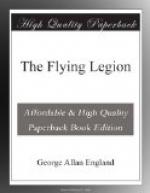He smiled, oddly.
“Many a corpse has been flung down this oubliette,” said he. “I hate to go, without emptying my pistol into a few more of the Moslem swine, and dropping them down here to join my people. But—I must!”
He bent, gathered together the silver lamps left by his men, and threw them all into the abyss. Blackness, absolute, blotted the reeking chamber from his sight.
The faintest possible aura of light began to loom from the mouth of the passage. More distinctly, now, the murmur of Arab voices was becoming audible.
The Master leaped.
Far below, at the bottom of the pit, as the Arabs burst into the wine-vault, sounded a final impact of some heavy body striking swift water that swept it instantly away.
Then silence filled the black, rock-hewn chamber in the labyrinthine depths of Jannati Shahr.
CHAPTER XLIX
THE DESERT
The Desert.
Four men, one woman.
Save for these five living creatures, all was death. All was that great emptiness which the Arabs call “La Siwa Hu”—that is to say, the land “where there is none but He.”
Over terrible spaces, over immense listening silences of hard, unbroken dunes extending in haggard desolation to fantastic horizons of lurid ardor, hung a heat-quivering air of deathlike stillness. Redder than blood, a blistering sun-ball was losing itself behind far, iron hills of black basalt. A flaming land it was, naked and bare, scalped and flayed to the very bones of its stark skeleton.
Heavily, and with the dazed look of beings who feel themselves lost yet still are driven by the life within them to press on, the five fugitives—pitiable handful of the Legion—were plodding south-west, toward the sunset.
The feet of all were cut and bleeding, in spite of rags torn from their tattered uniforms and bound on with strips of cloth; for everywhere through the sand projected ridges of vertical, sharp stone—the black basalt named by the Arabs Hajar Jehannum, or “Rock of Hell.” As for their uniforms, though now dry as bone, the way in which they were shrunken and wrinkled told that not long ago they had been drenched in water of strongly mordant qualities.
Each figure bore, on its bent back, a goat-skin bag as heavily filled with water as could be carried. Strongly alkaline as that water was, corroding to the mouth and nauseous to the taste, still the refugees were clinging to it. For only this now stood between them and one of the most hideous deaths known to man—the death of thirst in the wilderness.
The woman’s face, in spite of pain, anxiety, weariness, retained its beauty. Her heavy masses of hair, bound up with cloth strips, protected her head from “the great enemy,” the sun. As for the others, they had improvised rough headgear from their torn shirts, ingeniously tied into some semblance of cherchias. Above all, the Legionaries knew that they must guard their heads from the direct rays of the desert sun.




